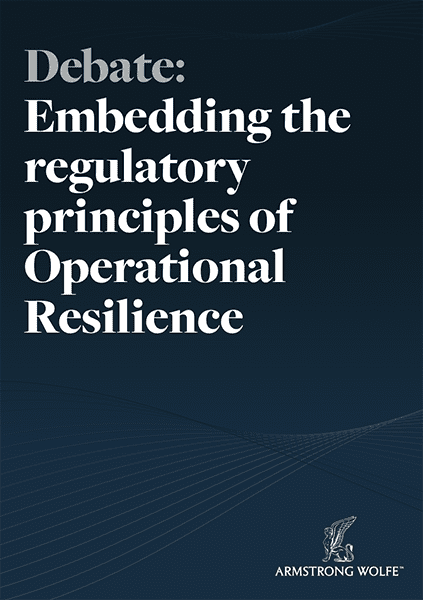“To accommodate this challenge in the mid to long term, some are diversifying and hiring at more junior levels, attracting prospective candidates into treasury who would formerly have been only attracted into a risk or trading environment.”
A LEAP OF FAITH
Market volatility and regulatory demands drive COOs to think laterally for talent
One of the key challenges for any business is meeting the staffing demands for precise technical skill-sets at peak times: if one bank is looking, they are probably all looking. In new areas such as 1LOD, being first into this area may well deliver first-starter disadvantage, allowing the development of a subject-matter talent pool for the followers to access. In response to this, COOs have begun to think laterally about how to meet these demands, asking themselves: “If the person for this role does not exist, what skills and experiences would be useful or necessary in role? Where can I find the right person with the right experience that we could leverage and train into this new role, or complement a team in which talent is in short supply?” The following is an example within liquidity risk.
In these turbulent times, risk management is a key concern for both board members and shareholders. Recent events in the global banking system have demonstrated the importance of identifying threats that could have a devastating impact on a business. The need to balance risk and control to enhance value to stakeholders and prevent loss has never been more apparent. While many areas of banking are facing headcount reduction, risk management and change within risk’s infrastructure are not under pressure to reduce headcount. Indeed, the contrary position is found, with high demands on risk management leading to a market-wide search for experienced talent. Why? Enhanced levels of risk and new demands placed upon it through regulation may combine with lack of experience in areas of new regulation, and this may require the strengthening of the Chief Risk Officer’s function. Hiring capable talent is central to meeting this demand.
At a time of such uncertainty, many risk managers are considering the personal risks of moving and are unsurprisingly seeking a premium to make a change in response to this career risk assessment and that the supply-and-demand equation is presently in their favour. These factors have ushered in compensation increases that are countercyclical to rest of the staffing market. The value of any offer is balanced against the role itself, pay and, importantly, market position and robustness of the bank making the offer. The banks that have managed their way through turbulent times in comparative good order are therefore well placed to both retain and secure talent within the risk management space.
The hunt for treasury talent
The demand is not just within the traditional risk areas of credit, market and operational risk management. Those experienced in liquidity risk are arguably in higher demand than all others, as banks struggle with market volatility and funding constraints. This is tied to the talent gap created by the flow of regulations and the need to understand, address and implement the necessary policies and procedures arising from them.
Transferability of the risk mind and skill-set from one risk discipline to another has put further pressures on the risk sector. While regulatory pressure on managing liquidity risks is valid, the more pressing practical problem is how to meet liquid capital needs while ensuring profitability in a time of low margins. Strategies for fine-tuning liquidity risk management practices appear to be a) liquidity risk policy development and b) liquidity management – arguably the key to better business agility and profitability. Here, experience and reliability are essential, and securing and retaining the right staff are placing acute demands on treasury functions as they seek to up-skill their departments.
Always the hub, now the nucleus
Treasury had always been seen as the hub of the organisation, but post-credit crunch, its role has become enhanced, more complex and significantly more important from both an internal and external perspective. Specifically, the impact of regulations relating to capital allocation, fund requirement and the internal demands of business heads is changing the profile of individuals required by treasury. Some talent may develop from within it, but the new skill-sets required demand that the treasury function must import aligned skills from global markets and/or aligned trading and risk management areas. Funding, balance sheet management, capital management and allocation, and liquidity risk management all demand an up-skilling to allow the treasury function to successfully meet the requirements of the business and match the requirements of the regulators.
Perhaps the greatest area of demand is within liquidity risk management, which many business heads see as the new market risk. Previously there was a requirement for reporting on historical events, which could be delivered through either the finance function or managed by those of finance heritage and training. However, the need for stress-testing liquidity ratios and to meet the demands of, for example, the head of equity for a more complex understanding of the implications on their business funding and capital requirements, means that people from a much stronger quantitative and risk background are required. This leaves most banks searching for talent from a limited and under qualified pool. Many banks have little choice but to identify aligned skills from other areas to strengthen their treasury function.
Route to talent and its implications
With treasury becoming a far more business-aligned function, and the evolution of liquidity risk management, banks will be forced to look into global markets and aligned trading areas to source talent with relevant experience. The immediate impact of this is to bridge the compensation gap between those paid a premium within global markets and the traditional treasury pay scales. Some banks are already halfway through this process, which has led to huge disparities within treasury compensation structures, particularly at the more senior levels.
It is estimated by some banks that even if the headcount remains flat, the allocated budget for treasury department compensation will increase by around 20%. This is partly due to migration of internal talent from global markets on parity – many banks are already concerned about losing treasury talent to an increasingly competitive market. This is accompanied by the need for many banks to seek external talent, where demand exceeds supply and manifests itself in compensation escalation. The price per hire has risen and continued to do so through the post-bonus period.
To accommodate this challenge in the mid to long term, some are diversifying and hiring at more junior levels, attracting prospective candidates into treasury who would formerly have been only attracted into a risk or trading environment. However, this remains a longer-term solution to an immediate need, and compensation for those with experience will escalate.
The three key skills in demand are as follows:
1. Those who are able to demonstrate an in-depth technical understanding of the business and its products to respond to increasing demands from the product and business heads.
2. Those with an in-depth and technical understanding of regulatory matters and those able to respond to evolving and changing circumstance.
3. Quantitative skills and in-depth understanding of key risk indicators.
Compensation
Our research shows that the EMEA regional treasury head is closely aligned to the reward of the functional and global heads of funding and liquidity/capital management, although research at VP to MD levels demonstrates a significant variance between 2013/2014 and 2015/2016 compensation levels and bonus payments.
This period of flux has often led to an incumbent at D to MD level hiring much-needed staff/managers and having to offer more than their own package to secure them. This is only palatable in the very short term and sets a justifiable expectation for a commensurate adjustment at year end. Furthermore, compensation can vary significantly depending upon where treasury roles reside – within the business, risk or finance.
Conclusion
This challenge is not in isolation. It can be found market-wide and represents a potentially significant staffing issue for many functions today, such as when the treasury function comes under pressure to up-skill accordingly. Alongside the current demand to manage cost, there is an acknowledgement of the need for an increase in treasury budgets to enable it to attract and retain its talent.
In the short term, the skill gap can/must be filled through the migration of talent from other areas (such as market risk) internally and externally. One treasury COO commented that it felt as if you were ‘robbing Peter to pay Paul’. However, in line with the further evolution of treasury and the demands upon it, mid- to long-term staffing requirements can only be fulfilled by a disciplined approach to attracting and securing emerging talent into a function with an enhanced role, level of importance and complexity.












